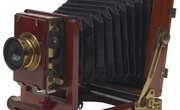After surviving the Great Depression and the strict rationing laws implemented during World War II, Americans were ready to indulge in the new prosperity of the 1950s. Easy access to modern conveniences, such as automobiles, televisions and refrigerators, contributed to a more leisurely lifestyle. These technologies also encouraged a more consumeristic attitude, especially among the younger generation, who defined their own cultural expressions.
The Golden Age of Television
With the expansion in television technology in the late 1940s, American ownership of the broadcasting box more than doubled from 1951 to 1957. Feeding the public's insatiable thirst, the industry rapidly added cable stations and debuted a variety of sitcoms and game shows in color. In April 1952, "I Love Lucy" set a new record when 10.6 million viewers tuned in simultaneously to watch the comedy show. The television revolutionized the way Americans received news, altered the dynamics of the family unit and inspired trend products such as TV dinners.
The Emergence of Teen Culture
Television also played a crucial role in the rise of youth culture in the 1950s. Fans could now see their idols on such popular programs as "American Bandstand," "The Ed Sullivan Show" and "The Mickey Mouse Club." Inspired by the fashion styles and rebellious attitudes of stars such as James Dean and Elvis Presley, teens were eager to challenge social boundaries. Jeans were widely adopted by teens as a symbol of independence.
The Invention of Rock Music
Rooted in the rhythm and blues pioneered by African American jazz musicians, young artists in the 1950s began experimenting with a new sound that blended blues and gospel with a heavy, uptempo backbeat. From the flamboyant Little Richard to the charismatic Buddy Holly, no artist had a greater impact on the development of rock 'n' roll than Elvis Presley. The pelvis-thrusting singer stole the hearts of young Americans with his first single in January 1956, "Heartbreak Hotel," which became a huge hit.
The Rise of Beatniks
In a backlash against the rising tide of consumerism and superficial pop culture, young adults in their twenties and thirties challenged traditional values with their nonconformity. Dressed in all black clothing, bohemian musicians, artists and writers gathered in their shabbily furnished "pads" to lament the shallowness of society, strategize social movements and construct new forms of expression. The 1950s witnessed the rise of freeform jazz and poetry, critical self-portraits and abstract drip paintings that sold for thousands of dollars. Noted creative personalities include "beat" writer Jack Kerouac, reclusive author J.D. Salinger and painter Jackson Pollock.
Related Articles
References
Writer Bio
A published writer since 1994, Nicole Kidder is the voice of Traditions Wedding Blog. As a cultural journalist, she has contributed to ColorsNW magazine, Travel News Maldives and Senior Health Weekly. Kidder holds a Bachelor of Arts in journalism from Seattle University and is a certified diversity trainer.











